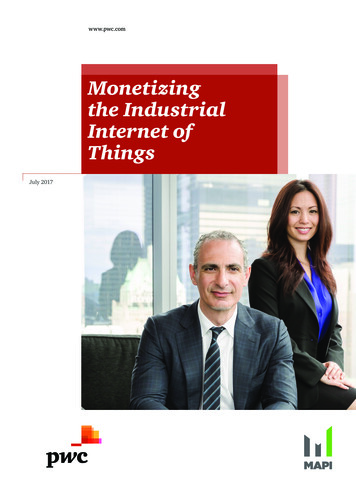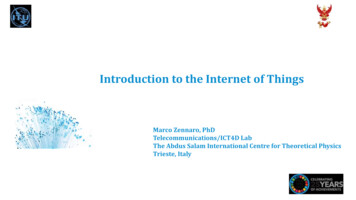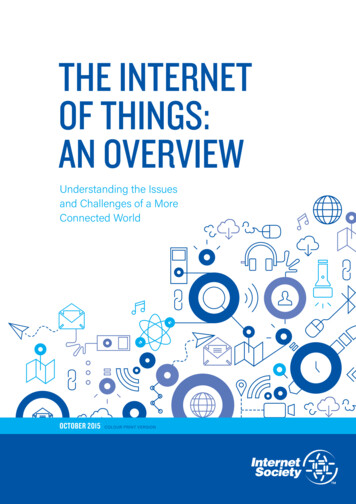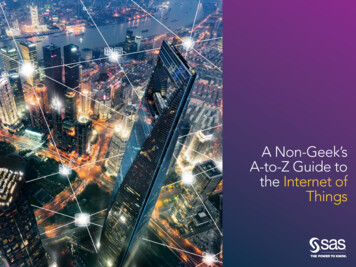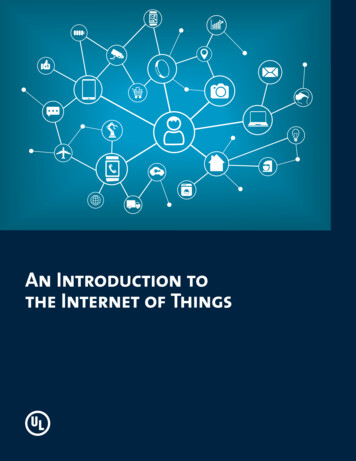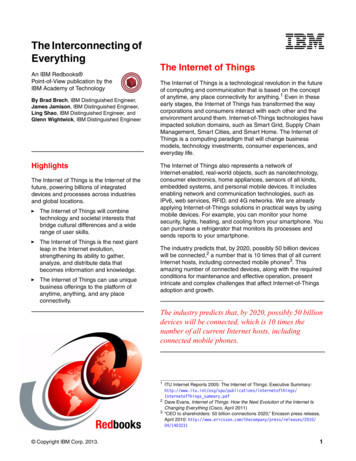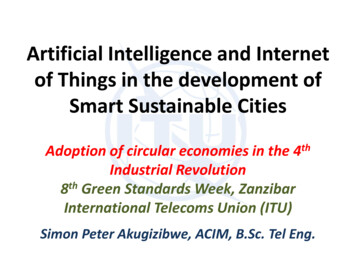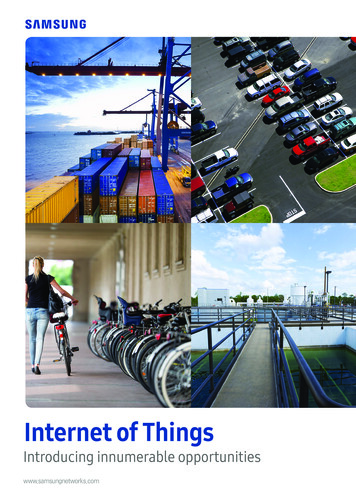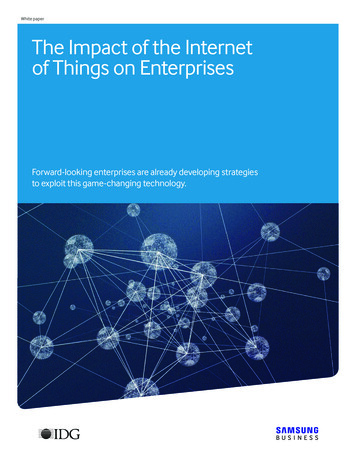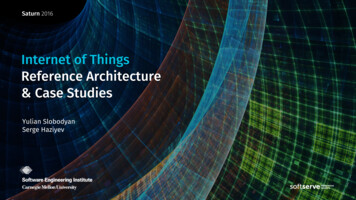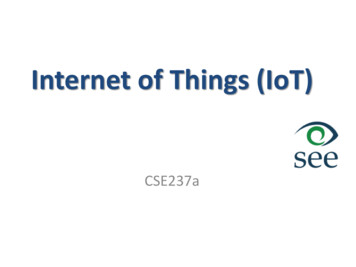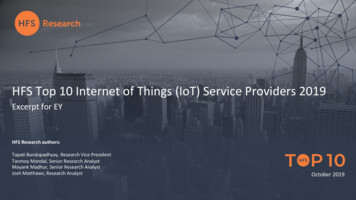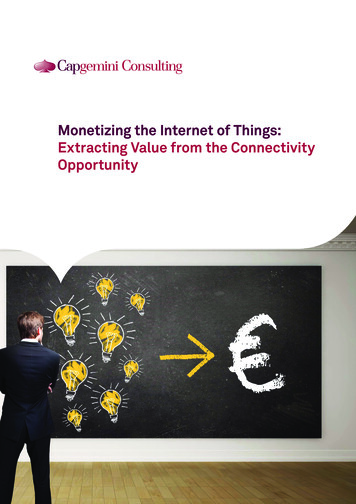
Transcription
Monetizing the Internet of Things:Extracting Value from the ConnectivityOpportunity
Why is it So Hard to Monetize the Internetof Things?Cisco estimates thatIoT has the potential togenerate about 19 trillionof value over the comingyears.Connectivity is not something that is confinedto humans. In fact, the number of connecteddevices has long surpassed the number ofhumans on the planet. And this machineto-machine connectivity is not limited toa select group of super-smart devices.Every-day objects now have sensors whosecapabilities might vary. This fundamental shiftis leading to an Internet that is far grander inscale and opportunity than we previouslyimagined. In fact, Cisco has estimated thatthis Internet of Things (IoT) has the potentialto generate about 19 trillion of value overthe coming years1.The staggering potential size-of-the-prize hascertainly caught the attention of the world’sbusiness community. In a recent survey ofsenior business leaders around the globe,96% said their companies would be usingIoT in some way within the next 3 years,while 68% said their companies are alreadyinvesting budgets in IoT2. However, there isa catch to all of this – most organizationsare yet to derive significant commercialvalue from IoT. Our recent research showsthat 70% of organizations do not generateservice revenues from their IoT solutions(see our report “The Internet of Things: AreOrganizations Ready for a Multi-Trillion DollarPrize?”, 2014)3.We have looked at why organizations arefalling short in monetizing the IoT, and seea combination of external and internalchallenges (see Figure 1). But there is acatch. Over 70% oforganizations do notgenerate service revenuesfrom their IoT solutions.Figure 1: Monetization Challenges for the IoTSecurity andPrivacy ConcernsHinder ConsumerAdoptionKey IoTMonetizationChallengesLack ofStandardsLimits RevenuePotentialSource: Capgemini Consulting analysis2SuccessfulMonetizationDemands SignificantInvestments in AcquiringNew Capabilities,Often without Clear Returns
Security and Privacy ConcernsHinder Consumer AdoptionLack of Standards Limits RevenuePotentialThe IoT creates an intertwined meshof systems and devices, which hugelycomplicates issues of information security.“Hacks” or attacks can happen at multiplelevels. They might be targeted at the deviceitself, or they can be carried out over thecommunication network over which thedata is transferred. The recent example ofa “hacked refrigerator” highlights both thenascent nature of this sphere of technologyand the significant security issues. As partof a large-scale hack attack over a numberof weeks, more than 750,000 maliciousemails were sent from more than 100,000everyday consumer devices, including –astonishingly – one report of a refrigerator4.Customers today are increasingly awareof these sorts of dangers. A recent surveyshowed that 69% of respondents wereconcerned that a connected appliancecould result in data breach of sensitiveinformation5. These issues are a significantchallenge to the consumer adoption of IoTofferings.IoT solutions deliver the most value whenthey are connected to a web of interlinkedservices. For instance, a smart homesolution can deliver significant value onlywhen it integrates the electrical, safetyand surveillance systems. However,our research indicates that only 13%of organizations offer IoT solutions thatintegrate with third-party products andservices (see our report “The Internet ofThings: Are Organizations Ready for aMulti-Trillion Dollar Prize?”, 2014)6. Thisprevents companies from tapping into alarger ecosystem of products and services,and significantly limits revenue enhancementopportunities. Unless standards are agreedupon – spanning industries, vendors andproducts – the potential of the IoT will remainunder-exploited.A recent survey indicatedthat 69% of respondentswere concerned that aconnected appliance couldresult in data breach ofsensitive information.Successful Monetization DemandsSignificant Investments in AcquiringNew Capabilities, Often withoutClear ReturnsMost product-centric organizationsneed to make significant investmentsin acquiring new functional capabilities,before they can sell IoT-based services.For instance, organizations need toaugment their product managementcapabilities with the skills needed todevelop and market services. Moreover,since connectivity reduces the time lagbetween the occurrence of an event andthe time taken for information to reachthe support center, customers are alsolikely to expect faster response times.As such, specialized customer supportteams need to be set up to respondrapidly to customer queries in real-time.Acquiring and building these additionalcapabilities entail significant effort andinvestment, often without a clear returnon investment in the short-term. Thesefactors delay monetization efforts.96% of companies willbe using IoT in some waywithin the next threeyears.It is pertinent to note that these are veryearly days in what is still a very fastdeveloping and immature marketplace.We have tried to capture some initialobservations on monetization in thecoming sections.Only 13% oforganizations offer IoTsolutions that integratewith third-party productsand services.3
How Can Organizations Profit from the IoT?On the conventional Internet, many ofthe current leading players have seentwo broad phases – phase 1 where theyfocused on traction, and a second phasewhere they focused on monetization.On the Internet of Things though, moststartups and incumbents are activelylooking at monetization models rightfrom the start. While these are still earlydays, there are four distinct models thatare emerging (see Figure 2).Product Selling is an Organization’sEntry into the IoT World“Hardware Premium” is the most basicform of monetization model. Here,organizations add connectivity optionsto an existing or new product and offerremote device management in theform of mobile apps. This basic levelof connectivity and control enablesorganizations to charge a premium fortheir product.An example of this model is LIFX (seeFigure 3), which produces remotelyprogrammable LED light bulbs that canbe controlled through a smart-phoneapp. These bulbs are sold at a premium,and are priced around 10 times higherthan a compact fluorescent bulb7.Product selling is anorganization’s entry intothe IoT world.From a consumer perspective, a keydriver for buying hardware premiumproducts is the novelty factor involved incontrolling hitherto standalone devices.Figure 2: Monetization Models for the IoTEcosystem BuildingSimplest model whereorganizations charge aprice-premium for theproduct’s connected featuresEx: LIFX, a remotelyprogrammable LED light bulbcontrolled by a smartphone appCollaborativeServiceRevenueRelationalHardware PremiumRelationship with CustomerEx: SmartThings sells itsown products and serviceswhile creating a platform forother IoT companies to sellservices that interlink with itIn this model, organizationsconvert what has been atraditional product into aservice by tying in a recurringpricing model for specific featuresDataRevenueIn this model organizationsgenerate revenues by sellingpackaged data gathered fromsensorsHardwarePremiumEx: Michelin Solutions packagesinsights generated from the datathat it gathers through sensorsembedded inside customer vehiclesBasicAdvancedComplexity of IoT Monetization ModelSource: Capgemini Consulting analysis4Ex: Volkswagen’s “Car-Net”service offers security features,maintenance assistance andnavigation tools for a setsubscription feeData RevenueTransactionalIn this model, organizationscreate a platform where theyideally make money from bothother product vendors andend consumersService RevenueEcosystemBuilding
Figure 3: LIFX Bulb and Smartphone AppService Bundling GeneratesRecurring Revenues through LongTerm Customer RelationshipsThe service model offers a recurringrevenue stream and, more importantly,creates a relationship with the customerlong after they have purchased aproduct.For example, Volkswagen’s “Car-Net” serviceoffers security features, maintenance assistance,and navigation tools for its customers fora subscription fee of 17.99/month and 199/year (see Figure 4). Customers canalso select from several features – forexample, automatic crash notificationscan be sent to chosen contacts whenairbags are deployed in the vehicle8.Source: Apple App Store listing of LIFX appFigure 4: Volkswagen’s Car-Net ServiceSimilarly, in the B2B segment, smartthermostat manufacturer Nest is using itsLearning Thermostat — a home automationand energy management product — asa platform to offer energy managementservices to utilities. Nest charges utilities 30to 50 per thermostat annually for its service.As part of the service, Nest helps utilitiesbetter understand their customers’ energyusage. Nest automatically reschedulesusage of equipment with high electricityconsumption such as air conditioners. Bydoing so, it has been able to reduce overallelectricity requirement by as much as 50%in peak times thus saving significant moneyfor utilities. Nest is currently installed in over 1million homes and close to 20 utilities havesigned up for the service9.Service bundling enablesorganizations to createlong-term relationshipswith the customer.Source: Company website5
Building a Smart Home, using the Ecosystem Model – SmartThingsSource: Company websiteSmartThings is an Internet of Things startup that offers a centralized hub and an assortment of both in-house and third-partyIoT products. The company was launched in 2012 and raised over 1.2 million on Kickstarter (a crowdfunding platform) within18 months. The company has a smartphone app that is used to control its hub and all of its connected devices. It offers broadguidance to developers who want to make products for its platforms offering them design guidelines. The hub is priced at 99.Various products that the company sells as part of the platform include locks, switches, environment sensors, alarms amongothers. SmartThings works with partners such as Belkin, Sonos, and Philips, and on operating systems such as Android andiOS. Over 1,000 devices and 8,000 applications have been made till August 2014 when the company was acquired by SamsungElectronics for approximately 200 million.Source: CNET, “Samsung snaps up SmartThings, embracing Internet of Things”, August 2014Data Generated in the IoT Offers aMonetization ModelIoT devices generate large volumes ofsensor data. For many organizations, theability to capture, package and sell thisdata offers a potential monetization model.Once this data has been aggregated andanonymized, organizations can chooseto sell it raw, package insights from it ormonetize it using advertizing.For instance, Michelin, through its MichelinSolutions unit, packages insights generatedfrom the data that it gathers throughsensors embedded inside customervehicles. Customers pay Michelin on a pervehicle, per-year basis.These insights helpits customers achieve a variety of goalsincluding reducing costs, carbon footprint,among others10.6Ecosystem Building AllowsMonetization from Dual-SidedMarketsThe IoT thrives in a connected ecosystem– the bigger the ecosystem, the greater isthe value generated for all stakeholders.In an ecosystem, the focus is not onselling a product or a service, but onproviding a shared platform to otherplayers in the ecosystem – hardwaremanufacturers, software developers,service providers and the like. In sucha model, the platform promoter ideallymakes money from both end customersas well as other platform users. Platformusers pay the promoter for listing and thepromoter also gets a share whenever aproduct is sold to the end customer on theplatform. A shared platform brings multiplebenefits to participants. For instance,with the APIs provided by the platformprovider, independent companies thathave IoT products/services can developcustom applications. SmartThings is anexample of a company that has taken theecosystem building approach towards amonetization model (see insert).An Ecosystem modelallows organizationsto generate value formultiple stakeholders– customers and otherplatform partners.
Multiple Pricing Models Enable Companies to Realize the Full Benefitsof IoT MonetizationPricing ModelExampleOne-time Charges: Customer pays a one-time price for purchasingthe offeringSells health-tracking wearabledevices for one-time costPay-For-Results: Allows customers to pay only for realized resultsfrom the IoT offeringRecovers payments as percentageof savings obtained from serviceFreemium: Allows organizations to attract customers that arenot convinced of the value of the offeringSubscription: Offers customers the flexibility to customize serviceoptions and duration of the serviceMonetization ModelHardware Premium Service/Data RevenueUses a freemium model forindustrial IoT servicesMonthly subscription for remotesecurity and energy managementService/Data RevenuePay-As-You-Go: Allows customers to pay according to the actualusage of the serviceSells pay-per-mile autoinsuranceSource: Capgemini Consulting analysisFor each IoT monetization model, we see a variety of pricing models that can be adopted.Pricing Models for Products and ServicesFor One-Time Charges, the customer pays a one-time price for purchasing the offering. This model is largely used with products,though it can be used with services too. A Subscription Model offers customers the flexibility to customize service options andthe duration of the service. A Pay-As-You-Go Model allows the customer to pay according to the actual usage of the service.The Pay-for-Results Model allows customers to pay only for realized results from the IoT offering – a strong value-based modelwhere the customer can see the RoI directly. For instance, IoT startup Enlighted builds devices that can detect heat, light, andmotion, and pairs them with a software system that can control lighting, heating and cooling based on the data these sensorscollect. Cu
SmartThings is an Internet of Things startup that offers a centralized hub and an assortment of both in-house and third-party IoT products. The company was launched in 2012 and raised over 1.2 million on Kickstarter (a crowdfunding platform) within 18 months. The company has a smartphone app that is used to control its hub and all of its connected devices. It offers broad guidance to .
